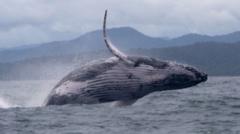Scientists are astounded by a humpback whale's extraordinary migration covering at least 13,000 km, from the Pacific coast of Colombia to the Indian Ocean near Zanzibar. Researchers suggest that this unusual journey may reflect shifts in food availability or the pursuit of new breeding grounds due to climate change.
Humpback Whale's Incredible Journey Highlights Climate Change Impacts

Humpback Whale's Incredible Journey Highlights Climate Change Impacts
A humpback whale's unprecedented migration from Colombia to Zanzibar raises concerns about climate change effects on marine life.
In a remarkable display of endurance and adaptability, a humpback whale has undertaken an unprecedented migration that has captivated marine biologists. Spotted in the Pacific Ocean off Colombia in 2017, this whale re-emerged in 2022 near Zanzibar in the Indian Ocean, achieving a stunning journey of at least 13,000 kilometers. This record-breaking trek has raised alarms among scientists, as it may signal underlying environmental challenges tied to climate change.
Dr. Ekaterina Kalashnikova of the Tanzania Cetaceans Program described the whale's journey as "truly impressive and unusual even for this highly migratory species." Notably, this migration may be the longest ever documented for a humpback whale, underscoring the effects of changing oceanic conditions on their behavior.
Humpback whales are known for their extensive migrations from tropical breeding grounds to nutrient-rich feeding sites in colder waters. However, this particular male's journey is strikingly unique, navigating across two vastly separated breeding habitats. Researchers propose that climate change may be diminishing the availability of essential food sources like krill, prompting the whale to travel further distances in search of sustenance.
The growing disturbances in marine environments—exacerbated by climate change—may also inspire humpbacks to explore new breeding locations, driven by increasing conservation efforts worldwide. "While the precise reasons for this migration remain uncertain, factors likely include global climatic changes, frequent extreme environmental events, and the species' evolutionary adaptations," added Dr. Kalashnikova.
The wandering male was first identified in the Colombian Pacific through photographs taken by scientists in 2013 and again in 2017. It wasn't until 2022 that it was spotted off the coast of Zanzibar, showcasing a minimum great-circle distance of over 13,046 km. Researchers stress that the actual distance may be considerably greater, given the spherical nature of Earth and its impact on migratory paths.
Key findings from this investigation utilized the efforts of numerous contributors to the citizen science platform, happywhale.com, where photos of whales are analyzed using artificial intelligence. This innovative technology allows for the tracking of individual humpbacks by matching the distinct shapes and patterns of their tails.
The results of this research were published in the journal, Royal Society Open Science, highlighting the vital role that citizen engagement and technology play in advancing our understanding of marine biology and environmental changes. As the implications of this whale's migration continue to unfold, it serves as a harbinger of the significant shifts in our oceans driven by climate change and the urgent need to protect marine ecosystems for future generations.



















